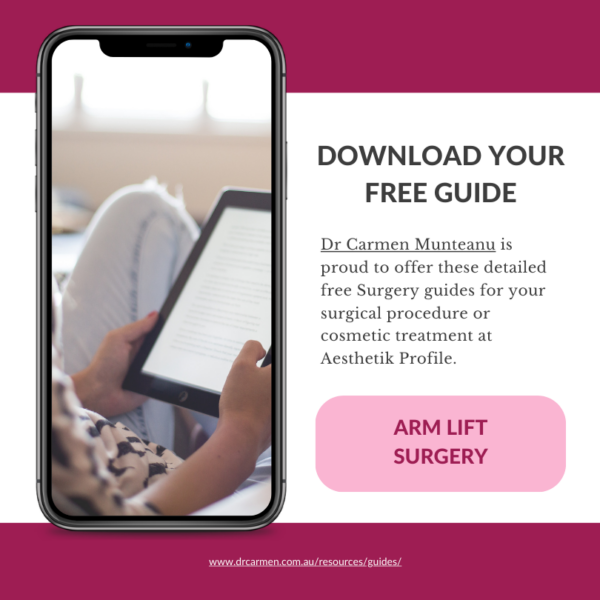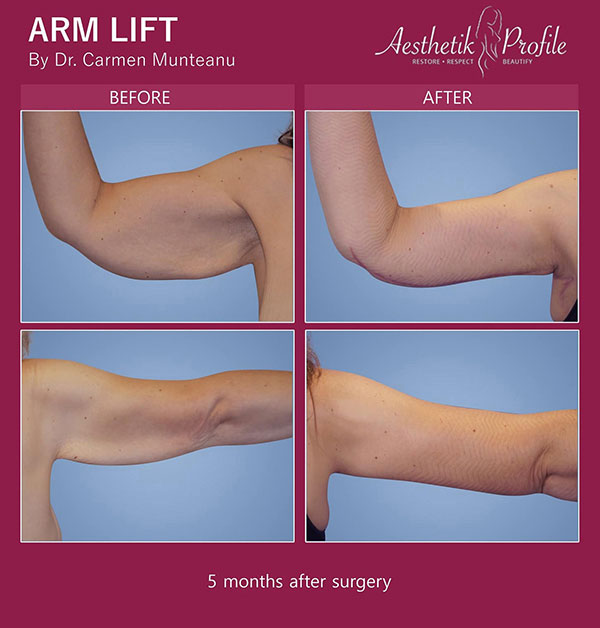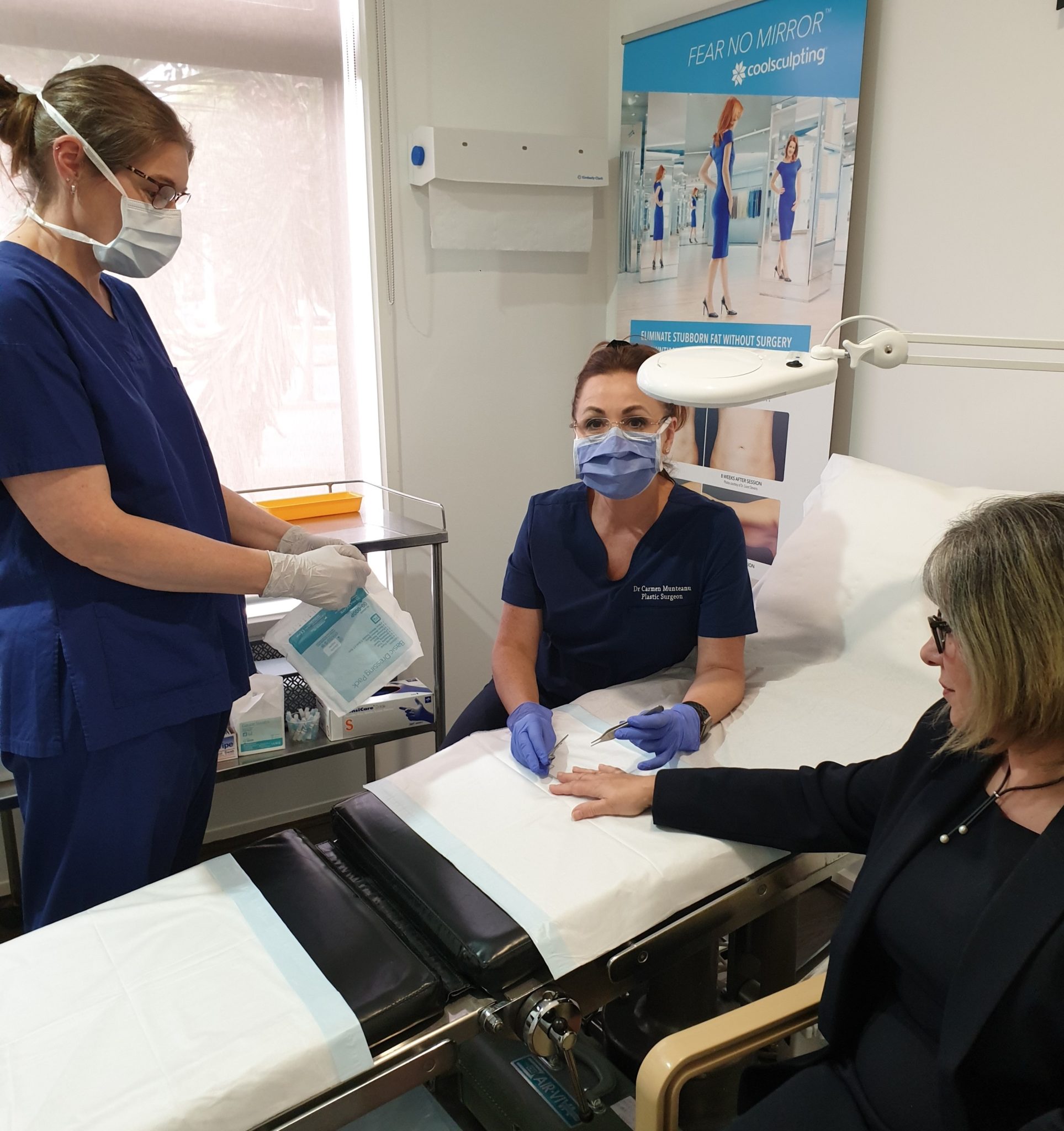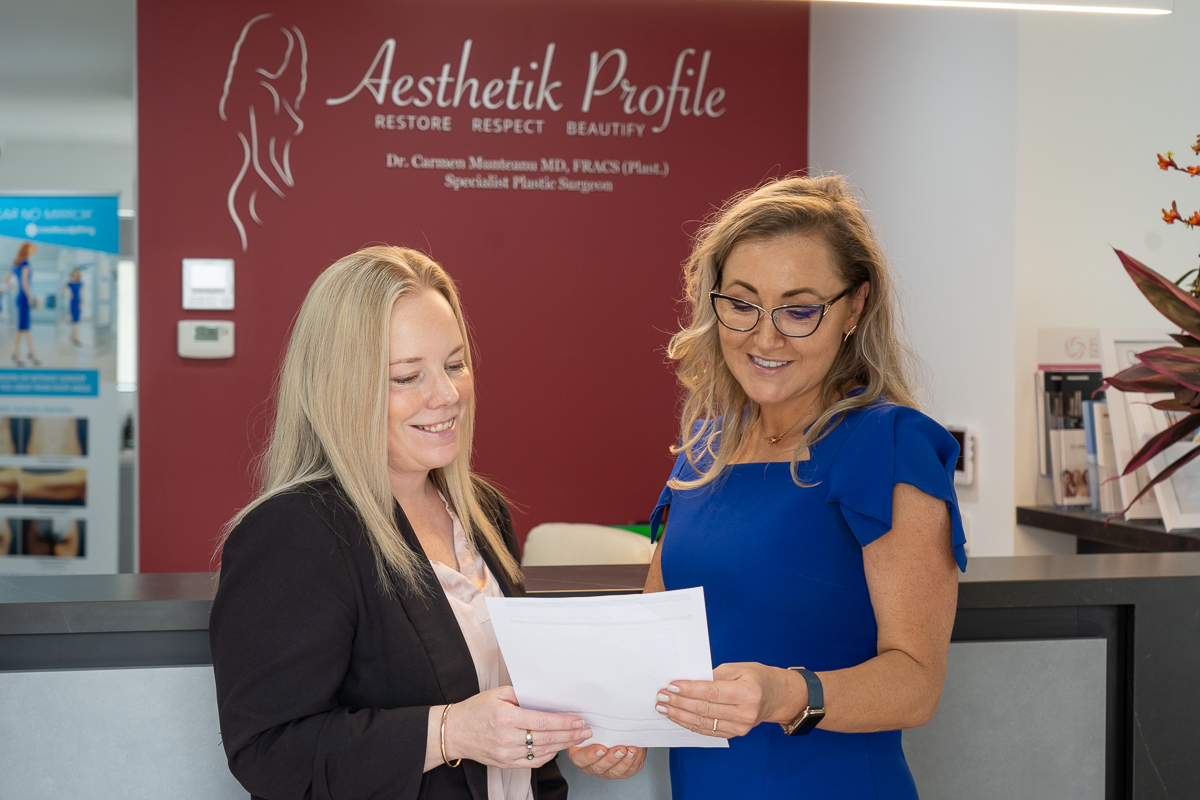Resuming Exercises after Brachioplasty
For individuals who’ve recently undergone arm lift surgery, the eagerness to return to their regular workout routines is understandable. However, like any other surgical procedure, arm lift surgery demands patience and understanding about when and how to safely resume physical exercises.
Dr Carmen Munteanu MD. FRACS (Plas) is a Melbourne specialist plastic surgeon performing arm lift surgery and other body procedures.
Download Dr Carmen’s Arm Lift Surgery Guide

What Is Arm Lift Surgery?
An arm lift, medically referred to as brachioplasty, stands as a surgical intervention meticulously crafted to eliminate the surplus skin and fat deposits on the upper arms. This procedure has gained popularity and is sought after by many for plenty of reasons. Some individuals are motivated to undergo the surgery due to noticeable alterations in the contour of their arms as they age. For others, it becomes an appealing option after they’ve undergone a significant weight reduction journey, which, although rewarding, can unfortunately leave them with sagging skin in the arm region. Additionally, there are those who inherently, perhaps due to their genetic makeup, experience an undesirable fullness in the underarm area, leading them to consider brachioplasty as a solution.
Recovery after Arm Lift Surgery
After undergoing an arm lift surgery, a patient enters a critical phase of healing, which is of paramount importance for realising the anticipated outcomes of the procedure. In the immediate days following the surgery, the body’s primary response revolves around mitigating the inflammation and effectively handling any associated discomfort or pain. This stage is foundational, setting the course for the subsequent recovery period. As the days progress, attention shifts to the more intricate aspects of healing, such as the mending of sutures and the recuperation of the internal tissues. These elements demand patience, ensuring they restore themselves optimally without any hitches. It’s worth noting that any haste in the recovery process, perhaps driven by eagerness or impatience, poses risks. Specifically, it can detrimentally affect the final visual appeal of the arm and, more importantly, its functionality, underscoring the necessity of adhering to recommended post-operative guidelines and timelines.

Guidelines for Resuming Exercise after Brachioplasty
Immediate Aftercare (0-1 Week)
The initial week post-surgery is an important time. It’s when your body is in the early stages of healing, and proper care is of the essence to ensure you’re on the right track. Here are some guidelines to adhere to:
Limit Movement
Your first instinct might be to check out the results, move your arm, and perhaps even attempt some minor tasks. It’s essential to exercise restraint.
- Excessive movement can cause tension on the freshly sutured site
- Avoid stretching or any activity that might pull at the stitches
- Give your body the time it needs to start the recovery process uninterrupted
Engage in Light Walking
While it’s essential to restrict certain activities, it’s equally important not to become entirely sedentary.
- Short, light walks around your home can be beneficial
- Walking helps in promoting blood circulation, which is essential for healing
- It can also help in preventing any potential complications, like blood clots
Avoid Lifting Heavy Objects
Your arms might feel okay, and you may assume lifting something small won’t be an issue. However, it’s essential to stay cautious.
- Even minor weights can place undue stress on the surgery site
- During this period, refrain from lifting anything that weighs more than 2-3 kgs
- If you need to pick up or move anything, consider seeking help or use other parts of your body, ensuring the arms aren’t strained
Short-term Recovery (1-3 Weeks)
Your body, having laid the foundation in the initial week, is now ready for more activity, albeit with caution.
Gradually Increase Walking Distance
While the first week was about introducing light walking, now it’s time to build on that.
- Walking is one of the simplest ways to boost circulation, essential for wound healing
- Try to extend your walking sessions, maybe around your neighbourhood or a local park, but always gauge how you feel and ensure you don’t overdo it
- Remember, the idea is not to exert but to keep the body active and agile
Introduce Light Stretching
Though you might be feeling better, remember the surgical site is still healing.
- Begin with gentle stretches, focusing on areas away from the surgical site, such as the lower body or neck
- Stretching can alleviate any stiffness you might feel from reduced activity in the first week
- Always be mindful and stop any stretch that feels uncomfortable or puts strain on your arms
Steer Clear of Strenuous Activities
Even as you add more activities, there are still some things to avoid.
- Any activity that might exert your arms or increase blood pressure needs to be sidestepped
- Lifting heavy objects is still off the table; ensure you’re not picking up anything too weighty
- It’s all about balance – introducing more movement without putting the recovery process at risk
Medium-term Recovery (3-6 Weeks)
Moving into the medium-term recovery phase is a significant milestone. You’ve laid a strong foundation in the prior weeks, and now your body’s increased resilience permits a broader range of activities.
Kick-off Low-impact Cardio Exercises
After weeks of restricted movement, your body might be yearning for some cardiovascular action.
- Stationary cycling is a fantastic choice; it gives the heart rate a boost without putting undue pressure on your arms
- If cycling isn’t your thing, consider brisk walking or even a low-impact aerobics class; the key is to elevate your heart rate gently
- Keep sessions short initially, then slowly extend them as your comfort and stamina grow
Integrate Light Resistance Training
Strength training can help in regaining muscle tone, but it’s essential to start small.
- Begin with lighter weights, focusing on areas like the legs or core
- While you might be keen to tone those arms, it’s essential to steer clear of direct arm workouts for now; there’s still healing happening underneath
- Using resistance bands can offer controlled resistance, giving you a workout while ensuring you don’t strain the surgical area
Amp up Your Stretching Regimen
Your body’s flexibility might be improving, and it’s a good time to up the ante.
- While increasing the stretch intensity, always remain aware of how your arms feel; pushing too hard is not the goal
- Incorporate stretches that engage multiple muscle groups, providing an all-round flexibility boost
- Yoga or Pilates can be considered, but be sure to inform the instructor about your recent surgery so they can advise on modifications
Long-term Recovery (After 6 Weeks)
Hitting the 6-week milestone in your recovery journey is indeed cause for a quiet celebration. You’ve navigated through the initial restrictive phases, and now the horizon looks a lot broader and full of possibilities.
Returning to Your Regular Exercise Routine
Having been restrained for a good few weeks, the allure of getting back to your favourite activities can be strong.
- Start by easing into your regular routine, rather than diving right in
- Listen to your body; if an exercise feels too intense or causes discomfort, it’s okay to pull back and give yourself more time
- It might be worth consulting a physical therapist or personal trainer familiar with post-surgery recovery to design a customised workout plan for you
Approaching Heavy Weight Lifting with Care
Lifting weights is a great way to tone up and build strength, but post-surgery, it requires extra consideration.
- Start with lighter weights and increase gradually, always ensuring your arms are comfortable with the added weight
- Getting guidance is invaluable; consider working with a trainer who can provide feedback on your form and technique to prevent strain on the surgical area
- Spread out your arm workouts, giving ample rest days in between to allow muscles and tissues to recover
Prioritise Comfort over Intensity
While pushing limits is often celebrated in the fitness world, your primary focus should be comfort and safety.
- Pain is a clear signal from your body; if you experience it while exercising, stop immediately
- Don’t compare your progress to pre-surgery levels; instead, celebrate the small wins and recognise the journey you’ve undertaken
- Make it a practice to warm up adequately before workouts and cool down afterwards, ensuring your muscles and joints are primed for activity
Factors Influencing Recovery Speed
Each person’s recovery journey after an arm lift surgery is unique. While the procedure itself plays a role, several personal factors come into play in determining how quickly one can get back to their routine.
Age and Overall Health
Age and general health play pivotal roles in how swiftly you might recover post-surgery. Younger individuals generally have the upper hand due to their naturally enhanced regenerative abilities. Additionally, if you’re someone who maintains good health, enjoys a balanced diet and stays active, you may find yourself on the faster track to healing. On the flip side, for those managing chronic conditions or with compromised immune systems, the path to recovery might be longer.
Type of Surgery
The specific type of arm lift surgery you undergo can influence your recovery duration. For instance, traditional brachioplasty, which entails larger incisions, usually has a more extended recovery phase compared to a limited incision arm lift. It stands to reason: the more extensive the surgery, the longer it often takes to bounce back.
Post-operative Care Adherence
Your commitment to following post-operative guidelines can make a world of difference. Adhering to your plastic surgeon’s advice and recommendations can expedite the healing process. Conversely, if you stray from the suggested care path, be it skipping exercises or dabbling in activities best avoided, you could be looking at extended healing durations.
Individual Healing Abilities
Lastly, every person is wired differently. While some have the advantage of rapid healing due to their genetic makeup or other inherent factors, others might take a bit more time. Regardless of your natural pace, creating an ideal environment for recovery – think plenty of rest, nutritious meals, and steering clear of harmful habits like smoking – can positively tilt the scales in your favour.
The journey post arm lift surgery is as much about mental resilience as it is about physical recovery. By ensuring a balanced diet, maintaining an optimistic mindset, and adhering to professional guidelines, you set the stage for a successful and sustainable outcome. Prioritise your well-being, stay patient, and soon enough, you’ll be back to your regular routine, enjoying the benefits of your procedure.
FAQs about Exercises after Arm Lift Surgery

How soon after my arm lift surgery can I start exercising again?
- While light walking is generally recommended in the first week after surgery to promote blood circulation, more strenuous activities should be approached with caution. Depending on the nature of your surgery and your individual recovery rate, returning to your regular exercise routine usually occurs after the 6-week mark. It’s essential always to consult with Dr Carmen before resuming any exercises.
Are there specific exercises I should avoid post-surgery?
- Yes, especially during the initial recovery phases. It’s essential to steer clear of any exercises that put direct strain on your arms or stretch the incision area. Activities involving heavy lifting or high-impact arm movements should be reintroduced gradually and ideally under professional guidance.
Can exercise impact the results of my arm lift surgery?
- If you rush into strenuous exercises too soon after the procedure, there’s a risk of compromising the final appearance and functionality of the operated area. Proper adherence to post-operative care guidelines, including a phased return to physical activity, ensures optimal results and preserves the benefits of the surgery.
What’s the best type of exercise to start with during my recovery?
- Low-impact cardio exercises, such as stationary cycling, are often recommended as you transition into the medium-term recovery phase (3-6 weeks). As you progress, you can reintroduce light resistance training, ensuring you avoid direct stress on your arms.
Should I consider working with a physical therapist during my recovery?
- Engaging with a physical therapist or personal trainer familiar with post-surgery recovery can be beneficial. They can guide you on safely reintroducing exercises, ensuring you achieve your fitness goals without compromising your healing process.Top of FormBottom of Form
Further Reading about Arm Lift Surgery with Dr Carmen
- Read Dr Carmen’s Arm Lift Surgery Page
- Read Dr Carmen’s Blog about How to Reduce Scars after Arm Lift
- Read Dr Carmen’s Blog about Arm Lipo vs Arm Lift
- Read Dr Carmen’s Blog about Recovery after Arm Lift Surgery
Medical References about Arm Lift Surgery
- Arm Contouring: Review and Current Concepts – PubMed
- Complications Associated with Brachioplasty – PubMed
- Upper Arm Lift – The Aesthetic Society
- Arm Lift – American Society of Plastic Surgeons
- Brachioplasty (Arm Lift): Surgery, Recovery & What To Expect – Cleveland Clinic


